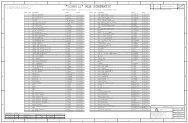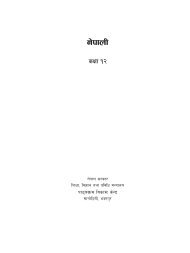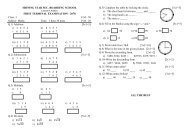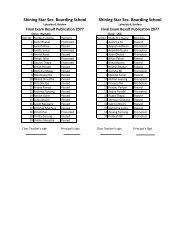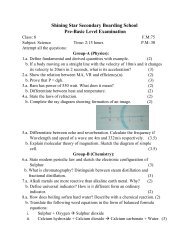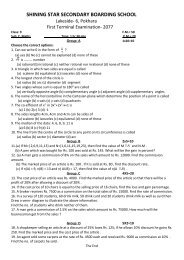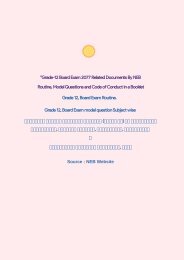keac1ps
You also want an ePaper? Increase the reach of your titles
YUMPU automatically turns print PDFs into web optimized ePapers that Google loves.
Accountancy<br />
Financial Accounting<br />
Part I<br />
Textbook for Class XI<br />
2020-21
ISBN 81-7450-507-5<br />
First Edition<br />
February 2006 Phalguna 1927<br />
Reprinted<br />
October 2006 Kartika 1928<br />
October 2007 Kartika 1929<br />
January 2009 Magha 1930<br />
January 2010 Magha 1931<br />
January 2011 Magha 1932<br />
June 2012 Jyaistha 1934<br />
April 2013 Chaitra 1935<br />
December 2013 Agrahayana 1935<br />
April 2015 Chaitra 1937<br />
December 2015 Pausa 1937<br />
March 2017 Phalguna 1938<br />
February 2018 Magha 1939<br />
February 2019 Magha 1940<br />
August 2019 Bhadrapada 1941<br />
PD 300T BS<br />
© National Council of Educational<br />
Research and Training, 2006<br />
<br />
<br />
<br />
ALL RIGHTS RESERVED<br />
No part of this publication may be reproduced, stored in a retrieval<br />
system or transmitted, in any form or by any means, electronic,<br />
mechanical, photocopying, recording or otherwise without the prior<br />
permission of the publisher.<br />
This book is sold subject to the condition that it shall not, by way of<br />
trade, be lent, re-sold, hired out or otherwise disposed of without<br />
the publisher’s consent, in any form of binding or cover other than<br />
that in which it is published.<br />
The correct price of this publication is the price printed on this<br />
page, Any revised price indicated by a rubber stamp or by a sticker<br />
or by any other means is incorrect and should be unacceptable.<br />
OFFICES OF THE PUBLICATION<br />
DIVISION, NCERT<br />
NCERT Campus<br />
Sri Aurobindo Marg<br />
New Delhi 110 016 Phone : 011-26562708<br />
108, 100 Feet Road<br />
Hosdakere Halli Extension<br />
Banashankari III Stage<br />
Bengaluru 560 085 Phone : 080-26725740<br />
Navjivan Trust Building<br />
P.O.Navjivan<br />
Ahmedabad 380 014 Phone : 079-27541446<br />
CWC Campus<br />
Opp. Dhankal Bus Stop<br />
Panihati<br />
Kolkata 700 114 Phone : 033-25530454<br />
CWC Complex<br />
Maligaon<br />
Guwahati 781 021 Phone : 0361-2674869<br />
` 135.00<br />
Printed on 80 GSM paper with<br />
NCERT watermark<br />
Published at the Publication Division<br />
by the Secretary, National Council of<br />
Educational Research and Training,<br />
Sri Aurobindo Marg, New Delhi 110<br />
016 and printed at Amar Ujala<br />
Publications Ltd., C-21-22, Sector-59,<br />
Noida - 201 301 (U.P.)<br />
Publication Team<br />
Head, Publication : M. Siraj Anwar<br />
Division<br />
Chief Editor : Shveta Uppal<br />
Chief Production : Arun Chitkara<br />
Officer<br />
Chief Business : Bibash Kumar Das<br />
Manager<br />
Assistant Editor : Gobind Ram<br />
Production Assistant : Prakash Veer Singh<br />
Cover<br />
Shweta Rao<br />
2020-21
FOREWORD<br />
The National Curriculum Framework (NCF), 2005, recommends that<br />
children’s life at school must be linked to their life outside the school. This<br />
principle marks a departure from the legacy of bookish learning which<br />
continues to shape our system and causes a gap between the school, home<br />
and community. The syllabi and textbooks developed on the basis of NCF<br />
signify an attempt to implement this basic idea. They also attempt to<br />
discourage rote learning and the maintenance of sharp boundaries between<br />
different subject areas. We hope these measures will take us significantly<br />
further in the direction of a child-centred system of education outlined in<br />
the National Policy on Education (1986).<br />
The success of this effort depends on the steps that school principals<br />
and teachers will take to encourage children to reflect on their own<br />
learning and to pursue imaginative activities and questions. We must<br />
recognise that, given space, time and freedom, children generate new<br />
knowledge by engaging with the information passed on to them by adults.<br />
Treating the prescribed textbook as the sole basis of examination is one<br />
of the key reasons why other resources and sites of learning are ignored.<br />
Inculcating creativity and initiative is possible if we perceive and treat<br />
children as participants in learning, not as receivers of a fixed body of<br />
knowledge.<br />
These aims imply considerable change in school routines and mode<br />
of functioning. Flexibility in the daily time-table is as necessary as rigour<br />
in implementing the annual calendar so that the required number of<br />
teaching days are actually devoted to teaching. The methods used for<br />
teaching and evaluation will also determine how effective this textbook<br />
proves for making children’s life at school a happy experience, rather<br />
than a source of stress or boredom. Syllabus designers have tried to<br />
address the problem of curricular burden by restructuring and<br />
reorienting knowledge at different stages with greater consideration for<br />
child psychology and the time available for teaching. The textbook<br />
attempts to enhance this endeavour by giving higher priority and space<br />
to opportunities for contemplation and wondering, discussion in small<br />
groups, and activities requiring hands-on experience.<br />
The National Council of Educational Research and Training (NCERT)<br />
appreciates the hard work done by the textbook development committee<br />
2020-21
iv<br />
responsible for this book. We wish to thank the Chairperson of the<br />
advisory group in Social Sciences Professor Hari Vasudevan and the Chief<br />
Advisor for this book, Professor R.K. Grover, (Retd.) Director, School of<br />
Management Studies (IGNOU), New Delhi for guiding the work of this<br />
committee. Several teachers contributed to the development of this<br />
textbook; we are grateful to their principals for making this possible. We<br />
are indebted to the institutions and organisations which have generously<br />
permitted us to draw upon their resources, material and personnel. We<br />
are especially grateful to the members of the National Monitoring<br />
Committee, appointed by the Department of Secondary and Higher<br />
Education, Ministry of Human Resource Development under the<br />
Chairpersonship of Professor Mrinal Miri and Professor G.P. Deshpande,<br />
for their valuable time and contribution. As an organisation committed<br />
to the systemic reform and continuous improvement in the quality of its<br />
products, NCERT welcomes comments and suggestions which will enable<br />
us to undertake further revision and refinement.<br />
Director<br />
New Delhi<br />
National Council of Educational<br />
20 December 2005 Research and Training<br />
2020-21
TEXTBOOK DEVELOPMENT COMMITTEE<br />
CHAIRPERSON, ADVISORY COMMITTEE FOR TEXTBOOKS IN SOCIAL SCIENCES AT<br />
UPPER PRIMARY LEVEL<br />
Hari Vasudevan, Professor, Department of History, University of Calcutta,<br />
Kolkata<br />
CHIEF ADVISOR<br />
R. K. Grover, Professor, (Retd.), School of Management Studies, IGNOU,<br />
New Delhi.<br />
MEMBERS<br />
A.K. Bansal, Reader, PGDAV College, Nehru Nagar, New Delhi.<br />
Amit Singhal, Lecturer, Ramjas College, Delhi University, Delhi.<br />
Ashwini Kumar Kala, PGT Commerce, Hiralal Jain Senior Secondary<br />
School, Sadar Bazar, Delhi.<br />
D.K Vaid, Professor, Department of Education in Social Sciences and<br />
Humanities, NCERT, New Delhi.<br />
Deepak Sehgal, Reader, Deen Dayal Upadhaya College, Delhi University,<br />
Delhi.<br />
H.V. Jhamb, Reader, Khalsa College, Delhi University, Delhi.<br />
Ishwar Chand, PGT Commerce, Government Sarvodaya Bal Vidyalaya,<br />
West Patel Nagar, New Delhi.<br />
K. Sambasiva Rao, Professor, Department of Commerce, Andhra<br />
University, Visakhapatnam.<br />
M. Srinivas, Professor, Department of Commerce, College for Women,<br />
Osmania University, Hyderabad.<br />
P.K. Gupta, Reader, Department of Management Studies, Jamia Millia<br />
Islamia, New Delhi.<br />
Rajesh Bansal, PGT Commerce, Rohtagi A.V. Senior Secondary School,<br />
Nai Sarak, Delhi.<br />
S.K. Sharma, Reader, Khalsa College, Delhi University, Delhi.<br />
2020-21
vi<br />
S.S. Sehrawat, Assistant Commissioner, Kendriya Vidyalaya Sangathan,<br />
Chandigarh.<br />
Savita Shangari, PGT Commerce, Gyan Bharati School, Saket, New Delhi.<br />
Shiv Juneja, PGT Commerce, Nirankari Boys Senior Secondary School,<br />
Paharganj, Delhi.<br />
Sushil Kumar, PGT Commerce, Government Sarvodaya Bal Vidyalaya,<br />
Kailash Puri, Delhi.<br />
Vanita Tripathi, Lecturer, Department of Commerce, Delhi School of<br />
Economics, Delhi University, Delhi.<br />
MEMBER-COORDINATOR<br />
Shipra Vaidya, Professor, Department of Education in Social Sciences<br />
NCERT, New Delhi.<br />
2020-21
ACKNOWLEDGEMENTS<br />
The National Council of Educational Research and Training<br />
acknowledges the valuable contributions of the Textbook Development<br />
Committee which took considerable pains in the development and review<br />
of manuscript as well.<br />
Special thanks are due to the Head, Department of Education in Social<br />
Sciences, NCERT for constant support, during the development of<br />
this book. We also acknowledge the contribution of all teachers of<br />
commerce who developed the extra learning material for QR codes in the<br />
textbook.<br />
The Council acknowledges the Contribution of Sanjeev Kumar,<br />
Vice Principal, Government Boys Senior Secondary School, Mata Sundari<br />
Road for reviewing and updating this textbook.<br />
The Contribution of APC-Office, administration of DESS, Publication<br />
Department and Secretariat of NCERT in bringing out this book are also<br />
duly acknowledged.<br />
2020-21
2020-21
CONTENTS<br />
FOREWORD<br />
iii<br />
Chapter 1 Introduction to Accounting 1<br />
1.1 Meaning of Accounting 2<br />
1.2 Accounting as a Source of Information 6<br />
1.3 Objectives of Accounting 10<br />
1.4 Role of Accounting 13<br />
1.5 Basic Terms in Accounting 14<br />
Chapter 2 Theory Base of Accounting 23<br />
2.1 Generally Accepted Accounting Principles (GAAP) 24<br />
2.2 Basic Accounting Concepts 25<br />
2.3 Systems of Accounting 33<br />
2.4 Basis of Accounting 34<br />
2.5 Accounting Standards 35<br />
Chapter 3 Recording of Transactions - I 46<br />
3.1 Business Transactions and Source Document 46<br />
3.2 Accounting Equation 50<br />
3.3 Using Debit and Credit 52<br />
3.4 Books of Original Entry 60<br />
3.5 The Ledger 72<br />
3.6 Posting from Journal 75<br />
Chapter 4 Recording of Transactions - II 99<br />
4.1 Cash Book 100<br />
4.2 Purchases (Journal) Book 125<br />
4.3 Purchases Return (Journal) Book 127<br />
4.4 Sales (Journal) Book 129<br />
4.5 Sales Return (Journal) Book 131<br />
4.6 Journal Proper 139<br />
4.7 Balancing the Accounts 141<br />
Chapter 5 Bank Reconciliation Statement 160<br />
5.1 Need for Reconciliation 161<br />
5.2 Preparation of Bank Reconciliation Statement 166<br />
2020-21
Chapter 6 Trial Balance and Rectification of Errors 180<br />
6.1 Meaning of Trial Balance 180<br />
6.2 Objectives of Preparing the Trial Balance 181<br />
6.3 Preparation of Trial Balance 184<br />
6.4 Significance of Agreement of Trial Balance 189<br />
6.5 Searching of Errors 191<br />
6.6 Rectification of Errors 192<br />
Chapter 7 Depreciation, Provisions and Reserves 226<br />
7.1 Depreciation 226<br />
7.2 Depreciation and other Similar Terms 230<br />
7.3 Causes of Depreciation 230<br />
7.4 Need for Depreciation 231<br />
7.5 Factors Affecting the Amount of Depreciation 232<br />
7.6 Methods of Calculating Depreciation Amount 234<br />
7.7 Straight Line Method and Written Down Method: 238<br />
A Comparative Analysis<br />
7.8 Methods of Recording Depreciation 240<br />
7.9 Disposal of Asset 249<br />
7.10 Effect of any Addition or Extension to the 259<br />
Existing Asset<br />
7.11 Provisions 262<br />
7.12 Reserves 264<br />
7.13 Secret Reserve 268<br />
Chapter 8 Bill of Exchange 277<br />
x<br />
8.1 Meaning of Bill of Exchange 278<br />
8.2 Promissory Note 280<br />
8.3 Advantages of Bill of Exchange 281<br />
8.4 Maturity of Bill 282<br />
8.5 Discounting of Bill 282<br />
8.6 Endorsement of Bill 282<br />
8.7 Accounting Treatment 283<br />
8.8 Dishonour of a Bill 290<br />
8.9 Renewal of the Bill 296<br />
8.10 Retiring of the Bill 298<br />
2020-21






